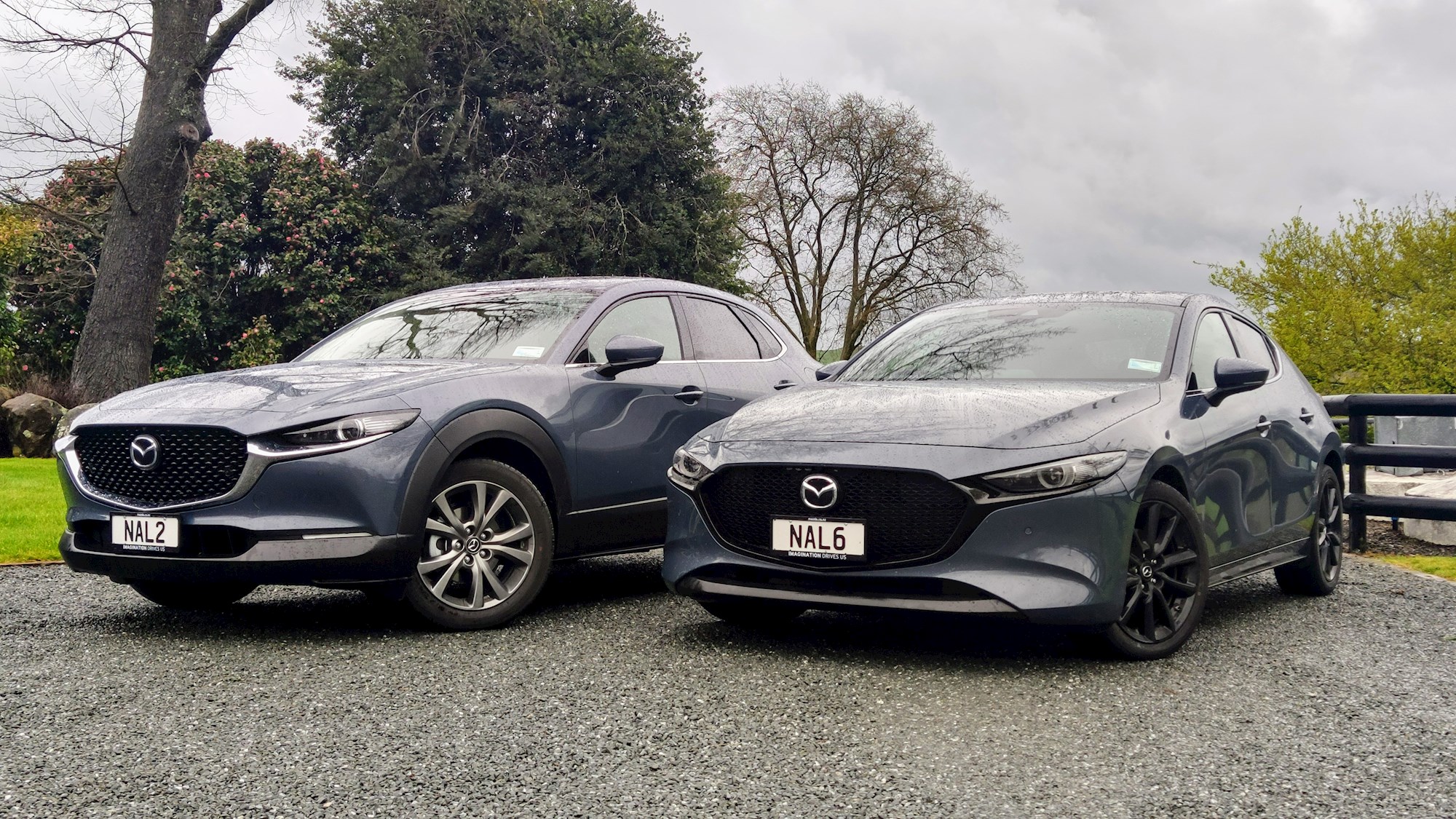Mazda rather modestly calls its SkyActiv-X engine technology a landmark moment in the 120-year history of the internal combustion engine.
The launch of SkyActiv-X in New Zealand with new flagship Takami models of the Mazda3 hatch and CX-30 SUV is something of a landmark moment for DRIVEN: we’ve been learning about and driving SkyActiv-X since 2017, all the way from the first public-road prototypes (hidden under the body of the previous-gen Mazda3) to the European launch of the production model last year.

The biggest unanswered question is “how much? But that’s now been settled with the arrival of the $51,995 Mazda3 Takami and $54,990 CX-30 Takami.
That’s an extra $3200 for the Mazda3 over the top SkyActiv-G version and $4000 for the CX-30, although the premium does include extra Takami equipment: both models get high-gloss alloy wheels (black for the Mazda3), upgraded leather upholstery, frameless rearvision mirror, heated steering wheel and 360-degree parking cameras.
The Mazda3 Takami adds larger exhaust pipes, while the CX-30 Takami gains a power tailgate (a curious omission on the rest of the range).
But what you’re really getting for your extra few thousand is that revolutionary new engine, which Mazda reckons is the first step on a path towards a hugely more efficient future for the Internal Combustion Engine (ICE).
SkyActiv-X is a simple concept with a dizzyingly complex execution. The explanation that follows is mostly in the first category.
Essentially, it’s a petrol engine that works like a diesel most of the time (that's why it's called "X" - a cross of the two technologies). SkyActiv-X can employ spark-ignition like a conventional petrol, but it can also quickly transition to a form of compression-ignition, like a diesel. The spark plug is still used at all times, but in Spark Controlled Compression Ignition (SPCCI) mode it acts as a control unit to help create separate zones of fuel-air mixture for lean burn.
There’s all sorts of extra tech at work in there, including a supercharger to help with the volume of high-pressure air required.
Why invest so much time and money in a revolutionary petrol engine when so many argue that ICE is in its twilight years? The inconvenient truth is that new powertrain technologies will take decades to dominate. Mazda says ICE will still power 95 per cent of its range in 2030, albeit with a lot of electrification (which SkyActiv-X has). And it is working on Battery Electric Vehicles (BEVs) as well, like the forthcoming MX-30.
Mazda is also fond of pointing out that a SkyActiv-X car is theoretically cleaner than a short-range BEV if the latter is not being run on sustainable electricity. On a “well to wheel” basis (fuel extraction and refinement all the way to filling and running the car), a SkyActiv-X generates 142g/km compared with 200g for the BEV (source fuel manufacture figures in case you’re shouting “fake news!” about now: Comprehensive Evaluation of Life Cycle CO2 Emissions of Electric Power Generation Technologies in Japan, Report Y06).
That’s not as relevant in NZ where we have very clean hydro electricity, but it does help explain the global thinking.
The holy grail for SkyActiv-X is the low-down flexibility and fuel economy of a diesel with the cleaner running, performance and rev-happy nature of a petrol.
The tech-minded will certainly be drawn to the new models, but they’ll be a more challenging showroom sell because the on-paper gains won’t blow your socks off.
The SkyActiv-X 2.0-litre mild hybrid powertrain makes 132kW/224Nm, compared with 114kW/200Nm for the SkyActiv-G 2.0l and 139kW/252Nm for the 2.5l.
Average fuel economy of 5.5l/100km for the Mazda3 SkyActiv-X and 6.0l for the CX-30 is about 10 per cent better than the SkyActiv-G 2.0l, although Mazda says the biggest gains from the diesel-like combustion are in high-stress low-speed running, where the X-factor improves things by over 15 per cent.
But in typical Mazda fashion, the company also says that data points don’t truly communicate the advantages. SkyActiv-X could have been configured for astonishing fuel economy, but that would be at the expense of performance. And vice-versa.
It says the real benefit of this new technology is in dramatically improved driveability and economy over the broadest possible range of real-world driving conditions.
After a day driving the new SkyActiv-X generation back-to-back with their SkyActiv-G 2.5l equivalents, it’s hard to disagree.
There’s a noticeably more muscular feel to the powerplant at low revs (it gets a 5-6kW bump from the mild hybrid system at times as well) which is undermined only by the occasionally staccato six-speed automatic gearbox – Mazda has all kinds of arguments why six is the right number of ratios, but SkyActiv-X would be magic with a seven or eight-speed.
The impressive cardio work continues through the mid-range and SkyActiv really does rev nicely up top, with a much better soundtrack than the SkyActiv-G unit. It’s actually a lot quieter in the Mazda3 than the CX-30 – but perhaps the latter has more of a sense of aural purpose.
The big dynamic difference between the Mazda3 and CX-30 Takami models is that the latter has high ride height and AWD, allowing you to deploy the power with a bit more enthusiasm on wet roads.
Aside from being our first chance to sample SkyActiv-X on local roads, the drive day was also a chance to drive Mazda3 and CX-30 back-to-back.
Now, I know everybody buys SUVs these days (essentially, the CX-30 is an SUV version of the Mazda3), but I came away more certain than ever that the Three is the jewel in Mazda’s crown.
Sensational looking, composed, refined and now unquestionably high-tech, I’d argue the Mazda3 Takami is not only now the most impressive thing Mazda makes – it’s also one of the most desirable premium hatchbacks you can buy.



